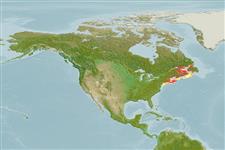>
Gadiformes (Cods) >
Gadidae (Cods and haddocks)
Etymology: Microgadus: Greek, mikros = samll + Latin, gadus = a fish, cod? (Ref. 45335); tomcod: Not available. See CoF (Eschmeyer, April 2006, Ref. 56787)..
More on author: Walbaum.
Environment: milieu / climate zone / depth range / distribution range
Ecologia
marino; acqua dolce; salmastro demersale; anadromo (Ref. 26213); distribuzione batimetrica 0 - 69 m (Ref. 57178). Temperate; 54°N - 36°N, 76°W - 56°W (Ref. 86798)
Northwest Atlantic: southern Labrador in Canada to Virginia in USA.
Size / Peso / Age
Maturity: Lm ? range ? - ? cm
Max length : 38.1 cm TL maschio/sesso non determinato; (Ref. 5951)
Spine dorsali (totale) : 0; Spine anali: 0. Body elongated; head small; eyes relatively small. Pelvic fins with a slightly elongated filament. Olive green brown or yellow dorsally, paler ventrally; with dark mottling on sides and fins.
Found in coastal, brackish and fresh water, landlocked in several lakes. Feeds mostly on small crustaceans, (especially shrimps and amphipods); also worms, small mollusks, squids and fishes (smelt, sticklebacks, striped bass, alewives, shed, herring and sculpins (Ref. 5951)) (Ref. 1371).
Life cycle and mating behavior
Maturities | Riproduzione | Spawnings | Egg(s) | Fecundities | Larve
Oviparous, sexes are separate (Ref. 205).
Cohen, D.M., T. Inada, T. Iwamoto and N. Scialabba, 1990. FAO species catalogue. Vol. 10. Gadiform fishes of the world (Order Gadiformes). An annotated and illustrated catalogue of cods, hakes, grenadiers and other gadiform fishes known to date. FAO Fish. Synop. 125(10). Rome: FAO. 442 p. (Ref. 1371)
IUCN Red List Status (Ref. 130435)
Threat to humans
Harmless
Human uses
Pesca: scarso interesse commerciale; Pesce da pesca sportiva: si
Strumenti
Special reports
Download XML
Fonti Internet
Estimates based on models
Preferred temperature (Ref.
123201): 2.7 - 12.6, mean 6.4 °C (based on 144 cells).
Phylogenetic diversity index (Ref.
82804): PD
50 = 0.7500 [Uniqueness, from 0.5 = low to 2.0 = high].
Bayesian length-weight: a=0.00398 (0.00186 - 0.00854), b=3.13 (2.94 - 3.32), in cm total length, based on LWR estimates for this (Sub)family-body shape (Ref.
93245).
Trophic level (Ref.
69278): 3.8 ±0.50 se; based on food items.
Resilienza (Ref.
120179): Medio, tempo minimo di raddoppiamento della popolazione 1.4 - 4.4 anni (Assuming tm=2-4).
Fishing Vulnerability (Ref.
59153): Low to moderate vulnerability (28 of 100).
Climate Vulnerability (Ref.
125649): High to very high vulnerability (75 of 100).
Nutrients (Ref.
124155): Calcium = 48 [26, 98] mg/100g; Iron = 0.354 [0.195, 0.622] mg/100g; Protein = 17.7 [16.4, 19.1] %; Omega3 = 0.414 [0.202, 0.847] g/100g; Selenium = 11.7 [5.8, 26.8] μg/100g; VitaminA = 13.4 [3.7, 47.0] μg/100g; Zinc = 0.656 [0.458, 0.956] mg/100g (wet weight);
